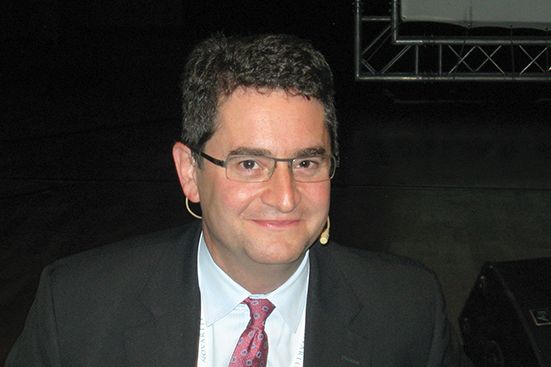User login
Compared with etanercept, secukinumab was associated with significantly faster and greater improvements in skin-specific quality of life among adults with moderate to severe psoriasis, according to a pooled analysis of data from the randomized, multicenter phase III ERASURE and FIXTURE trials.
The findings confirm the clinical superiority of secukinumab and extend prior head-to-head comparisons of this IL-17A inhibitor and etanercept, said Bruce E. Strober, MD, PhD, of the University of Connecticut in Farmington, Conn.
ERASURE and FIXTURE compared secukinumab (weekly for 4 weeks, then once-monthly) with etanercept (twice weekly for 12 weeks, then once-weekly) and placebo. Both secukinumab doses outperformed etanercept and placebo based on coprimary endpoints of PASI 75 and the proportion of patients who were clear or almost clear on a 5-point modified investigator’s global assessment (N Engl J Med. 2014 Jul 24;371[4]:326-38). A subsequent analysis showed that the clinical superiority of secukinumab held up at 52 weeks (J Dermatolog Treat. 2016;27[1]:1).
Because health-related quality of life is of increasing interest in psoriasis, Dr. Strober and his associates analyzed ERASURE and FIXTURE data on the Dermatology Life Quality Index (DLQI), a 10-item assessment of daily activities, leisure, personal relationships, symptoms and feelings, treatment, and work or school. Their analysis included 572 patients who received 300 mg secukinumab, 572 patients who received 150 mg secukinumab, and 326 patients who received 50 mg etanercept.
Baseline DLQI scores were similar among treatment groups. By week 4, significantly more secukinumab than etanercept recipients reported DLQI scores of 0 or 1 (DLQI 0/1), indicating that psoriasis was not impairing their quality of life (P < .05). This difference remained significant through week 52 at the 300-mg dose. The 150-mg dose significantly outperformed etanercept by week 8, and the difference remained significant through week 48.
In all, 81% of patients who received 300 mg secukinumab reported DLQI 0/1 at week 24, compared with 71% of those who received 150 mg secukinumab and 55% of those who received etanercept (P < .001 for each comparison with etanercept).
Among patients with complete data available, 86% of 300-mg secukinumab recipients achieved DLQI 0/1 at week 24, maintained this response through 52 weeks, and achieved a 90%-100% reduction in PASI total score at week 24. That was true of only 75% of etanercept recipients (P = .02, compared with 300 mg secukinumab) and 79% of 150-mg secukinumab recipients (P = .4, compared with etanercept).
In an adjusted model, patients who received 300 mg secukinumab were 1.9 times more likely to reach DLQI 0/1 than those who received etanercept (95% confidence interval, 1.6-2.3). Median time to response to both doses of secukinumab was 12 weeks, versus 24 weeks for etanercept (P < .0001).
This analysis offers “a robust, longer-term head-to-head comparison” of how secukinumab and etanercept affect quality of life in psoriasis, the researchers wrote. “Future research should consider replicating this evaluation using real-world long-term data and including other aspects of patient-centered outcomes, such as work productivity and psoriasis-related symptoms.”
Novartis funded ERASURE and FIXTURE. Dr. Strober reported financial ties to AbbVie, Amgen, Novartis, and several other pharmaceutical companies.
Compared with etanercept, secukinumab was associated with significantly faster and greater improvements in skin-specific quality of life among adults with moderate to severe psoriasis, according to a pooled analysis of data from the randomized, multicenter phase III ERASURE and FIXTURE trials.
The findings confirm the clinical superiority of secukinumab and extend prior head-to-head comparisons of this IL-17A inhibitor and etanercept, said Bruce E. Strober, MD, PhD, of the University of Connecticut in Farmington, Conn.
ERASURE and FIXTURE compared secukinumab (weekly for 4 weeks, then once-monthly) with etanercept (twice weekly for 12 weeks, then once-weekly) and placebo. Both secukinumab doses outperformed etanercept and placebo based on coprimary endpoints of PASI 75 and the proportion of patients who were clear or almost clear on a 5-point modified investigator’s global assessment (N Engl J Med. 2014 Jul 24;371[4]:326-38). A subsequent analysis showed that the clinical superiority of secukinumab held up at 52 weeks (J Dermatolog Treat. 2016;27[1]:1).
Because health-related quality of life is of increasing interest in psoriasis, Dr. Strober and his associates analyzed ERASURE and FIXTURE data on the Dermatology Life Quality Index (DLQI), a 10-item assessment of daily activities, leisure, personal relationships, symptoms and feelings, treatment, and work or school. Their analysis included 572 patients who received 300 mg secukinumab, 572 patients who received 150 mg secukinumab, and 326 patients who received 50 mg etanercept.
Baseline DLQI scores were similar among treatment groups. By week 4, significantly more secukinumab than etanercept recipients reported DLQI scores of 0 or 1 (DLQI 0/1), indicating that psoriasis was not impairing their quality of life (P < .05). This difference remained significant through week 52 at the 300-mg dose. The 150-mg dose significantly outperformed etanercept by week 8, and the difference remained significant through week 48.
In all, 81% of patients who received 300 mg secukinumab reported DLQI 0/1 at week 24, compared with 71% of those who received 150 mg secukinumab and 55% of those who received etanercept (P < .001 for each comparison with etanercept).
Among patients with complete data available, 86% of 300-mg secukinumab recipients achieved DLQI 0/1 at week 24, maintained this response through 52 weeks, and achieved a 90%-100% reduction in PASI total score at week 24. That was true of only 75% of etanercept recipients (P = .02, compared with 300 mg secukinumab) and 79% of 150-mg secukinumab recipients (P = .4, compared with etanercept).
In an adjusted model, patients who received 300 mg secukinumab were 1.9 times more likely to reach DLQI 0/1 than those who received etanercept (95% confidence interval, 1.6-2.3). Median time to response to both doses of secukinumab was 12 weeks, versus 24 weeks for etanercept (P < .0001).
This analysis offers “a robust, longer-term head-to-head comparison” of how secukinumab and etanercept affect quality of life in psoriasis, the researchers wrote. “Future research should consider replicating this evaluation using real-world long-term data and including other aspects of patient-centered outcomes, such as work productivity and psoriasis-related symptoms.”
Novartis funded ERASURE and FIXTURE. Dr. Strober reported financial ties to AbbVie, Amgen, Novartis, and several other pharmaceutical companies.
Compared with etanercept, secukinumab was associated with significantly faster and greater improvements in skin-specific quality of life among adults with moderate to severe psoriasis, according to a pooled analysis of data from the randomized, multicenter phase III ERASURE and FIXTURE trials.
The findings confirm the clinical superiority of secukinumab and extend prior head-to-head comparisons of this IL-17A inhibitor and etanercept, said Bruce E. Strober, MD, PhD, of the University of Connecticut in Farmington, Conn.
ERASURE and FIXTURE compared secukinumab (weekly for 4 weeks, then once-monthly) with etanercept (twice weekly for 12 weeks, then once-weekly) and placebo. Both secukinumab doses outperformed etanercept and placebo based on coprimary endpoints of PASI 75 and the proportion of patients who were clear or almost clear on a 5-point modified investigator’s global assessment (N Engl J Med. 2014 Jul 24;371[4]:326-38). A subsequent analysis showed that the clinical superiority of secukinumab held up at 52 weeks (J Dermatolog Treat. 2016;27[1]:1).
Because health-related quality of life is of increasing interest in psoriasis, Dr. Strober and his associates analyzed ERASURE and FIXTURE data on the Dermatology Life Quality Index (DLQI), a 10-item assessment of daily activities, leisure, personal relationships, symptoms and feelings, treatment, and work or school. Their analysis included 572 patients who received 300 mg secukinumab, 572 patients who received 150 mg secukinumab, and 326 patients who received 50 mg etanercept.
Baseline DLQI scores were similar among treatment groups. By week 4, significantly more secukinumab than etanercept recipients reported DLQI scores of 0 or 1 (DLQI 0/1), indicating that psoriasis was not impairing their quality of life (P < .05). This difference remained significant through week 52 at the 300-mg dose. The 150-mg dose significantly outperformed etanercept by week 8, and the difference remained significant through week 48.
In all, 81% of patients who received 300 mg secukinumab reported DLQI 0/1 at week 24, compared with 71% of those who received 150 mg secukinumab and 55% of those who received etanercept (P < .001 for each comparison with etanercept).
Among patients with complete data available, 86% of 300-mg secukinumab recipients achieved DLQI 0/1 at week 24, maintained this response through 52 weeks, and achieved a 90%-100% reduction in PASI total score at week 24. That was true of only 75% of etanercept recipients (P = .02, compared with 300 mg secukinumab) and 79% of 150-mg secukinumab recipients (P = .4, compared with etanercept).
In an adjusted model, patients who received 300 mg secukinumab were 1.9 times more likely to reach DLQI 0/1 than those who received etanercept (95% confidence interval, 1.6-2.3). Median time to response to both doses of secukinumab was 12 weeks, versus 24 weeks for etanercept (P < .0001).
This analysis offers “a robust, longer-term head-to-head comparison” of how secukinumab and etanercept affect quality of life in psoriasis, the researchers wrote. “Future research should consider replicating this evaluation using real-world long-term data and including other aspects of patient-centered outcomes, such as work productivity and psoriasis-related symptoms.”
Novartis funded ERASURE and FIXTURE. Dr. Strober reported financial ties to AbbVie, Amgen, Novartis, and several other pharmaceutical companies.
FROM JOURNAL OF THE AMERICAN ACADEMY OF DERMATOLOGY
Key clinical point: Secukinumab was associated with faster and greater improvements in self-reported quality of life, compared with etanercept, in adults with moderate to severe plaque psoriasis.
Major finding: In all, 81% of patients who received 300 mg secukinumab reported DLQI 0/1 at week 24, compared with 71% of those who received 150 mg secukinumab and 55% of those who received etanercept (P < .001 for each comparison with etanercept).
Data source: A pooled analysis of the randomized, multicenter, phase III ERASURE and FIXTURE trials.
Disclosures: Novartis funded ERASURE and FIXTURE. Dr. Strober reported financial ties to AbbVie, Amgen, Novartis, and several other pharmaceutical companies.

